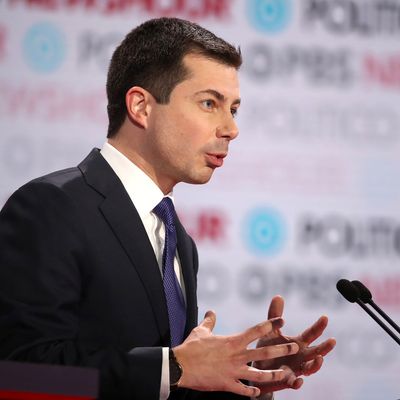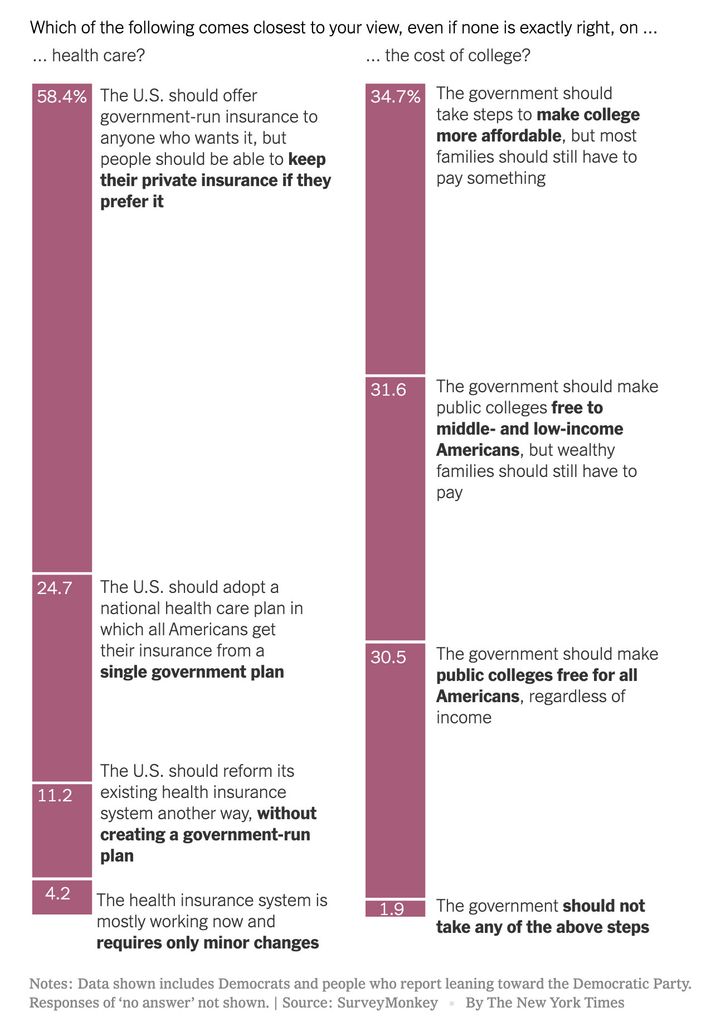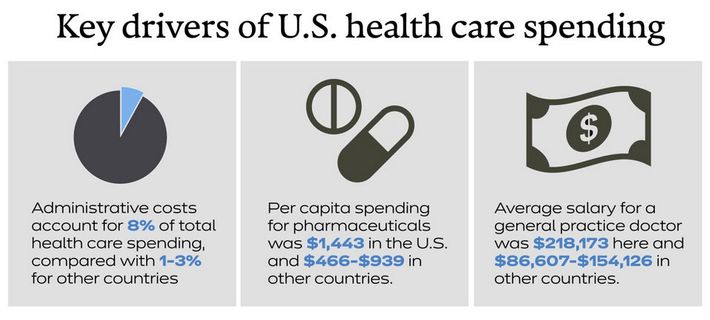
The vast majority of Americans believe that every U.S. citizen has a right to quality, affordable health care, and that it is the federal government’s job to uphold that right.
But roughly 70 percent of Americans also believe that their own health-care coverage is either “good” or “excellent” (despite the fact that virtually all of us are getting ripped off). This perennial poll result reflects the fact that voters often evince status-quo bias and loss aversion, which is to say, they tend to fear losing what they have more than they long for something better. In the U.S., this tendency is likely exacerbated by the public’s (understandable) distrust in their governing institutions.
For these reasons, Democratic operatives argue that Medicare for All Who Want It is a safer campaign pitch than Medicare for All. The former, as described by Pete Buttigieg and Joe Biden, would achieve universal coverage by giving all Americans the option of enrolling in a high-quality, affordable public health insurance program, while allowing the loss-averse to stick with the lousy private plans they know and trust. Medicare for All, by contrast, would force all Americans onto a single government plan, an approach to universal coverage that would ostensibly be more socially disruptive and fiscally onerous than a public option.
And surveys suggest the operatives are right: When the debate is framed in the terms outlined above, a public option consistently outpolls Medicare for All — even among Democratic voters. In a recent New York Times–SurveyMonkey poll, 58 percent of Democratic respondents said that the statement “The U.S. should offer government-run insurance to anyone who wants it, but people should be able to keep their private insurance if they prefer it” matched their view on health-care policy, while just 25 percent said the same of the assertion, “The U.S. should adopt a national health-care plan in which all Americans get their insurance from a single government plan.”

This shouldn’t be surprising. It’s hard to see why anyone who isn’t a self-identified social democrat or progressive policy wonk would find the latter idea more appealing. In the poll’s framing, the public option is no risk, all reward; you can enroll in a government plan or “keep” the one you already have (a benefit that Americans don’t actually enjoy under the existing employer-provided insurance system). Single-payer, by contrast, offers risk without any specified benefit. Thus, unless you happen to be versed in the arguments for Medicare for All’s superiority to a public option, you’ll be liable to hear the question as, more or less, “Would you rather have your cake and eat it, too, or be forced to choose between those alternatives?”
But the actual choice that Democratic candidates are offering the public is far more complicated.
There is no “glide path” to universal coverage, only rocky roads.
In truth, the kind of public option that Biden and Buttigieg are campaigning on — one robust enough to make universal health care a reality in the United States — would not allow all Americans to “keep their private insurance if they prefer it.” In fact, their plans would guarantee massive disruptions to private coverage. As a campaign slogan, “Medicare for All Who Want It” reconciles the electorate’s desire for universal coverage with its aversion to disruptive change. But as a policy, it doesn’t – because no policy can.
The reason is straightforward. Unlike most other OECD countries, the United States never imposed strict cost controls on its health-care sector. And since human beings are willing to pay most any price to avoid death or severe illness — and since insurance often masks the true cost of medical services — America’s hospitals, doctors, and drug companies have been able to secure payment rates several times higher than their peers in other nations. To appreciate how thoroughly we’re being hosed by our health-care sector, consider this: In 2018, Canada spent roughly 11 percent of its GDP on health care, which was enough to provide all of its citizens with premium-free access to the world’s 14th highest performing health-care system. That same year, the United States spent roughly 18 percent of its GDP on health care — which, in our system, was not sufficient to provide any form of insurance to nearly 30 million Americans, nor to prevent more than 50 percent of our people from delaying or forgoing medical care due to affordability concerns.

In this context, there is no way to provide all Americans with high-quality, affordable health care without radically disrupting the status quo. To extend quality coverage to the millions of Americans who are uninsured or underinsured, you either need to force providers to accept drastically lower payment rates — which is to say, upend the business models underpinning nearly one-fifth of the U.S. economy — or increase federal spending on health care beyond Bernie Sanders’s wildest dreams. The estimated price tag on the Vermont senator’s plan is (infamously) $32.6 trillion a decade. But that estimate assumes that the federal government would force large pay cuts on health-care providers, while securing administrative efficiencies through the elimination of redundant private insurance bureaucracies. A plan that sought to provide universal, comprehensive health coverage — without disrupting private insurers or imposing big pay cuts on hospitals and doctors — would be vastly more expensive.
Biden and Buttigieg haven’t filled in the fine details of their public options. But both suggest that their plans would be comprehensive, less expensive than comparable private plans, and available to all Americans. As the former vice-president puts it, “Whether you’re covered through your employer, buying your insurance on your own, or going without coverage altogether, the Biden Plan will give you the choice to purchase a public health insurance option like Medicare,” and, “As in Medicare, the Biden public option will reduce costs for patients by negotiating lower prices from hospitals and other health care providers.”
If this is an accurate description of Biden’s plan, then Biden’s plan will not allow most Americans to “keep their private insurance,” at least, not for long. Private firms will never have as much pricing power as the federal government, nor as much capacity to provide coverage at a loss. If Uncle Sam uses his singular market power to force down costs — and doles out sufficient subsidies to make his “public option” universally affordable — then the private insurance industry as we’ve known it will cease to exist. Meanwhile, to make the provider payment cuts sustainable, America’s approach to financing hospitals and medical schools would need to be radically restructured. And to make the public option fiscally sustainable — once the vast majority of Americans have enrolled in it — President Biden would need to propose tax increases nearly as large as those put forward by Sanders and Warren.
Mainstream news outlets (and Democratic debate moderators) have almost all either ignored or failed to comprehend these facts. This is likely because, in the Beltway’s popular consciousness, the phrase “public option” is still associated with the policy that Democrats nearly implemented under Barack Obama. In 2009, the House passed a version of the Affordable Care Act that would have established a public health insurance plan. But even if that public option had survived the Senate, it wouldn’t have been available to 90 percent of the already insured because the House bill restricted eligibility for that plan to the small minority of Americans who purchase insurance for themselves, rather than through their employers. What’s more, the 2009 public option did not seek to outcompete insurers by forcing big cuts on providers. In fact, the Congressional Budget Office estimated that the public plan would have higher premiums than most of its private competitors on the ACA’s exchanges, and that only about 6 million Americans would choose to enroll in it.
That kind of public option wouldn’t require hiking taxes or disrupting private insurance. It also wouldn’t ensure universal coverage. Biden and Buttigieg are, in essence, promising to deliver all the benefits of single-payer, at the political and fiscal cost of a marginal provision of the ACA. And the press has largely affirmed their “free pony” pitch. But the health-care industry isn’t fooled. The hospital, pharmaceutical, insurer, and physicians’ lobbies acknowledge no distinction between Medicare for All and a strong public option, and are already funding messaging campaigns against both.
It will take a “political revolution” to pass Joe Biden’s health-care plan.
All of which is to say, when Medicare for All Who Want It stops being a campaign pitch, and becomes a bill before Congress, it will face almost all of the same political obstacles as single-payer. Unless Biden and Buttigieg are misrepresenting the content of their plans, or their own commitment to universal coverage, then their health-care policies will require Congress to vote to (effectively) abolish the private insurance industry as we’ve known it, slash doctors’ salaries and hospitals profits, enact hefty tax increases, and disrupt the existing insurance coverage of millions of Americans.
Precisely because the health-care industry is such a gargantuan parasite on the U.S. economy, it will be willing and able to inundate the airwaves with negative messaging on a public option. Many doctors will likely warn their patients that those “clowns in Congress” are trying to disrupt their coverage, while many physicians’ groups will mount protests and lobbying campaigns. And the face of the opposition won’t just be high-paid hospital executives or millionaire surgeons. When you let an industry commandeer 18 percent of GDP, many millions of working-class Americans will owe their livelihoods to that industry. In cities throughout the country, (price-gouging) hospitals are the top employers. Private insurers provide jobs for 2.7 million Americans. Substantively, that is an indictment of the existing system, not a defense of it. Workers are a scarce resource, and the fact that millions currently labor for an industry that produces little to nothing of social value is an outrage. But politically, private insurance workers are a sympathetic interest group invested in the status quo. Sanders’s bill includes funds to help those displaced workers regain their footing in the labor market. Such workers would likely rally in opposition to Medicare for All, regardless; people typically do not like losing a source of stable employment, and the past three decades of trade policy have given American workers no reason to trust the government’s promises of retraining and reemployment. But Biden and Buttigieg’s plans don’t even offer such promises.
To be sure, the obstacles to getting a strong public option through Congress would not be identical to those of Medicare for All. The fiscal cost of the former would be much lower in the short term, and somewhat lower in the long term, as Sanders’s specific version of single-payer is exceptionally comprehensive in its benefits, and includes no cost-sharing. Further, although the public option’s broad popularity may be partially attributable to misunderstanding, those poll numbers are nevertheless politically helpful. And while Democratic candidates and the media are wildly underselling how disruptive a public option would be, the policy would still be less disruptive in the immediate term than Medicare for All.
That said, a strong public option would also present its own unique political liabilities. To achieve universal coverage through a premium-funded public option — as Buttigieg has proposed — you need to automatically enroll the uninsured in the plan, and then bill them for a service they never signed up for. As the Washington Post reported this week, this would ostensibly function as “supercharged individual mandate,” where (in the words of socialist policy wonk Matt Bruenig) instead of “paying a $695 fine at the end of the year for being uninsured, you are hit with a bill to pay an entire year of premiums that could be ten times that amount.” (Buttigieg’s plan would cap total premium costs at 8.5 percent of an enrollee’s income.)
Further, to the extent that public option proposals lack detailed transition plans for when they render private insurers uncompetitive, they’re liable to create more medium-term disruption than single-payer. And in the short term, unlike single-payer, a public option would not have all U.S. doctors in its provider network. In fact, if the new public plan is linked to Medicare – such that any doctor who accepts the latter must accept the former – it is possible that some physicians would stop seeing Medicare enrollees, so as to avoid having their practices flooded with patients whose insurance pays the low government rates.
But such hairsplitting is beside the point, which is that passing a strong public option — or any genuinely universal health-care plan — will require fomenting a nigh-unprecedented “political revolution.”
It will take a minor miracle for Democrats to secure a two-vote Senate majority in 2021; in which case, Kyrsten Sinema — a “Blue Dog” Democrat who has suggested that she might prefer Trump to a progressive in 2020 — will be the median Senate vote. This month, legislation outlawing the odious practice of “surprise billing” could not make it out of a House where Democrats boast a 36-vote majority. That bill had 78 percent support in opinion polls, and enjoyed the backing of the insurance industry. But hospitals and certain specialty physicians wanted to preserve their God-given right to charge $26,000 for a throat swab. So, they spent millions on a lobbying campaign to kill the provision. So, it died.
The honest, pragmatic case for the public option is that it will be impossible to pass.
The honest, pragmatic argument for Democrats to campaign on Medicare for All Who Want It instead of Medicare for All in 2020 goes something like this: There is zero chance of enacting either policy in the near future because the health-care industry is too powerful, America’s governing institutions are too corrupt, the Senate is too biased against progressives, and the vast majority of enfranchised Americans are too healthy, ill-informed, or terrified of change to realize that their existing coverage is neither “excellent” nor “good.” Thus, universal health care ain’t happening in 2021, no matter what gets written into the 2020 Democratic platform. We’re just gonna have to let Big Health Care keep eating a larger and larger chunk of our economy, while nonaffluent residents of the world’s wealthiest country keep losing loved ones to preventable illnesses.
Nevertheless, for whatever reason, the mainstream media is both very hostile to single-payer and extremely friendly to a public option — so friendly, major news outlets routinely frame the latter as a policy that would end all disruption in the private insurance market, and give all Americans access to a high-quality, low-cost public plan. Given these realities, running on Medicare for All would marginally reduce the Democrats’ odds of winning the presidency in 2020, while doing nothing to meaningfully advance the cause of universal health care. And winning in 2020 does matter, even if it will be insufficient for achieving universal health care: With the White House and a slim Senate majority, Democrats could realistically be expected to make marginal improvements to the health-care system (perhaps, if we’re lucky, improvements that make the fight for universal a bit easier down the road); increase funding for clean-energy R&D; restore civil-rights enforcement at the DOJ; adopt more progressive labor, financial, and environmental regulations; and forestall the conservative movement’s complete domination of the federal courts, among other things. Therefore, Democrats should run on the more popular, politically impossible health-care plan.
I personally don’t find this argument 100 percent persuasive. But it does strike me as coherent and difficult to dismiss. Anyhow, if every moderate Democrat and center-left pundit started framing their preference for a public option in these terms, it might make the American public a bit less complacent about the status-quo health-care system, and a bit more sympathetic to calls for radical change. (Which may be one reason why we’re hearing so many dishonest arguments for the public option instead.)






























